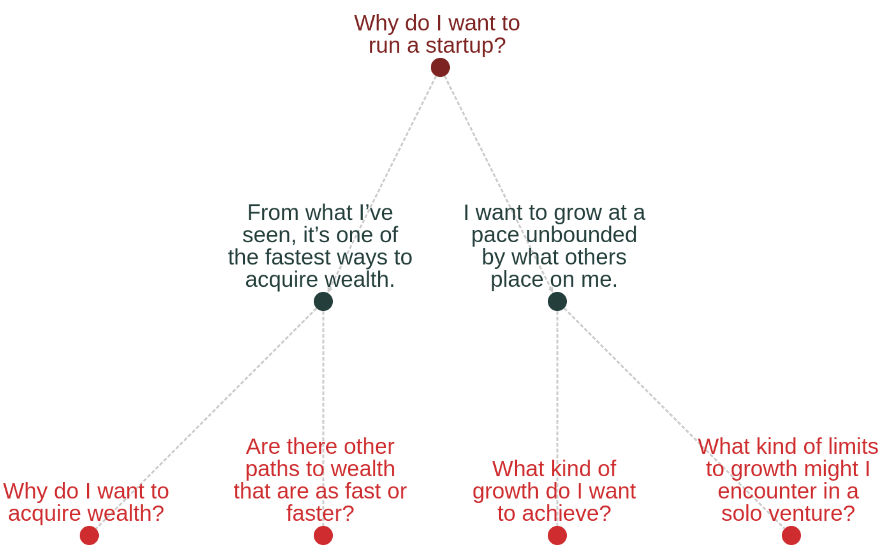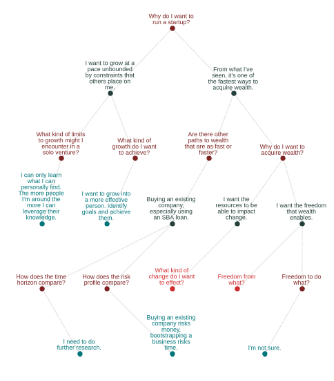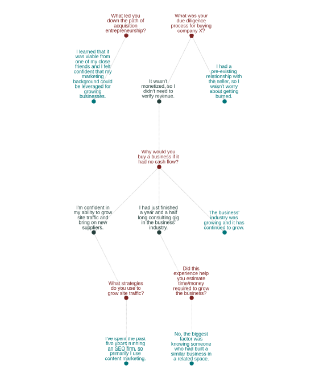I’m most comfortable using a fork to eat pasta. I am quite skilled at using a fork. Therefore, I should use a fork to chop down the tree in my backyard.

One of the most devilish problems I’ve encountered in my life is that of unknown unknowns. When I’m facing a problem I want solved, I tend to rely on familiar tools. If I know better tools exist and I have time to learn, I invest the time in education.
But I don’t know what tools I don’t know. When I don’t know if better tools exist and simply use the tools I’m familiar with, I often end up hobbling myself by trying to cut down a tree with a fork.
Lately, I’ve been doing a lot of self reflection: therapy, journaling, talking with friends. In the process, I’ve realized there’s a severe limitation in all of these tactics.
Conversation is linear, thoughts are not.
In having a conversation, in reading or writing sentences, you comprehend one word at a time in a linear order. However, the process of introspection isn't so simple.
Questions rarely have single answers and those answers often spawn multiple questions. Because conversation can only traverse one thread at a time, 9 times out of 10 a conversation ends with some thoughts left unexplored.
I’ll give a personal example of the limits to using traditional journaling and conversations for introspection. Let’s dig into why I feel drawn to running a startup.
Question: Why do I want to run a startup?
Answer 1: From what I’ve seen, it’s one of the fastest ways to acquire wealth.
Answer 2: I want to grow at a pace unbounded by what others place on me.
Questions about Answer 1: Why do I want to acquire wealth? Are there other paths to wealth that are as fast or faster?
Questions about Answer 2: What kind of growth do I want to achieve? What kind of limits to growth might I encounter in a solo venture?
In just two levels of introspection, we went from one question to four questions. If I were discussing this with somebody, chances are we would focus on digging deep in a specific direction and forget all of the other unexplored ideas.
Conversations aren’t built for thorough idea exploration. Google Docs, which I’m using for the initial drafts of this writing, is not built for thorough idea exploration. Using these tools for introspection is like using a fork for chopping wood.
But coming from a Computer Science background, I realized there is a tool that works perfectly for this. A graph.
This is what most people know as a graph. This might be what you know as a graph. This is not what I’m talking about. The only time I’ve seen people use these types of graphs for introspection is when they’re questioning their investing decisions.
The types of graphs I’m talking about look like this.

Why do CS people call these graphs when everyone else thinks of graphs as those line charts? Same reason CS people call data stored in your browser a cookie. That is to say, not a good reason.
Naming confusion aside, these types of graphs are actually extremely useful, especially in solving my introspection problem. Why? Because identifying and traversing every mental thread becomes easy and visually obvious.


With graphs, tracking unexplored lines of thought becomes just as easy as tracing thoughts to their root. You can engage in the deep dives that conversations and journaling excel at without losing any of the tangents along the way.
When I first started using these graphs, I only used them for introspection. In the process I found them useful for avoiding getting stuck in mental cycles as well as identifying topics that I should further explore.
But as I continued using them I realized that in addition to introspection, I could also use journal graphs to strengthen conversations with others. I could keep track of our conversation's branching paths and guide us down unexplored paths that we would've otherwise forgotten.
Originally, I drafted up an extremely minimal version of a journal graph tool solely for my own personal wellbeing. But after some friends and family expressed interest, I polished it up a bit for others to use. You can try it out below.
Here’s a quick video showing how to get started:
"I've found pursuing goals to be easy when things are going well. When they aren't, I've sometimes lose track of why I'm pursuing these goals in the first place. I've found it helpful to fully flesh out my goals, which leads to me either solidifying my goals or identifying different goals to pursue."

"I recently reached out to somebody who was already succeeding at what I wanted to do. They were open to sharing what they knew, so I began asking them my prepared questions. But for every question I had, they would provide multiple answers, which which lead to many more questions. Copying the conversation from text to my journal graph helped me make sure all of my questions were at least asked, if not answered."
